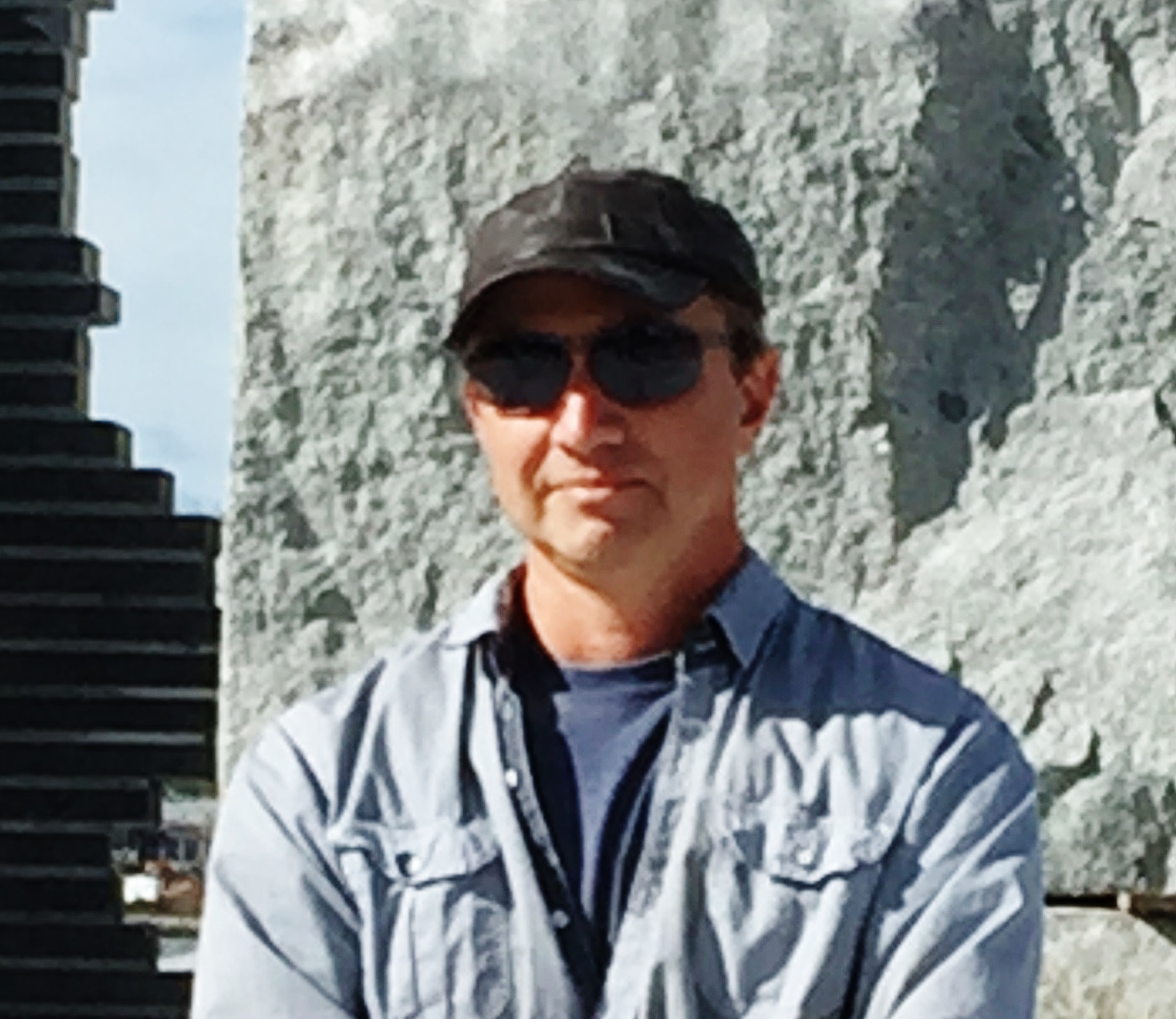 As an art student I was influenced by two accomplished sculptors who followed their passion in very different ways. I explored figurative sculpture inspired by John Fisher while working at his Italian studio, and conceptual sculpture under John Greer, my art college professor. Both these artists have taken their careers to a very high place, a lifelong pursuit and though they may not know it, I owe a lot to them. I regret not diving deeper into both figurative and conceptual art while I had the opportunity to work with them. There is something innately beautiful doing figurative work as well as satisfying bringing a theoretical concept into the three-dimensional world.
As an art student I was influenced by two accomplished sculptors who followed their passion in very different ways. I explored figurative sculpture inspired by John Fisher while working at his Italian studio, and conceptual sculpture under John Greer, my art college professor. Both these artists have taken their careers to a very high place, a lifelong pursuit and though they may not know it, I owe a lot to them. I regret not diving deeper into both figurative and conceptual art while I had the opportunity to work with them. There is something innately beautiful doing figurative work as well as satisfying bringing a theoretical concept into the three-dimensional world.But being a head-strong young artist, I moved away from both figurative and conceptual art and started my own exploration of metaphorical art. As I got interested in a subject, I would explore the topic through several sculptures that often spanned years.
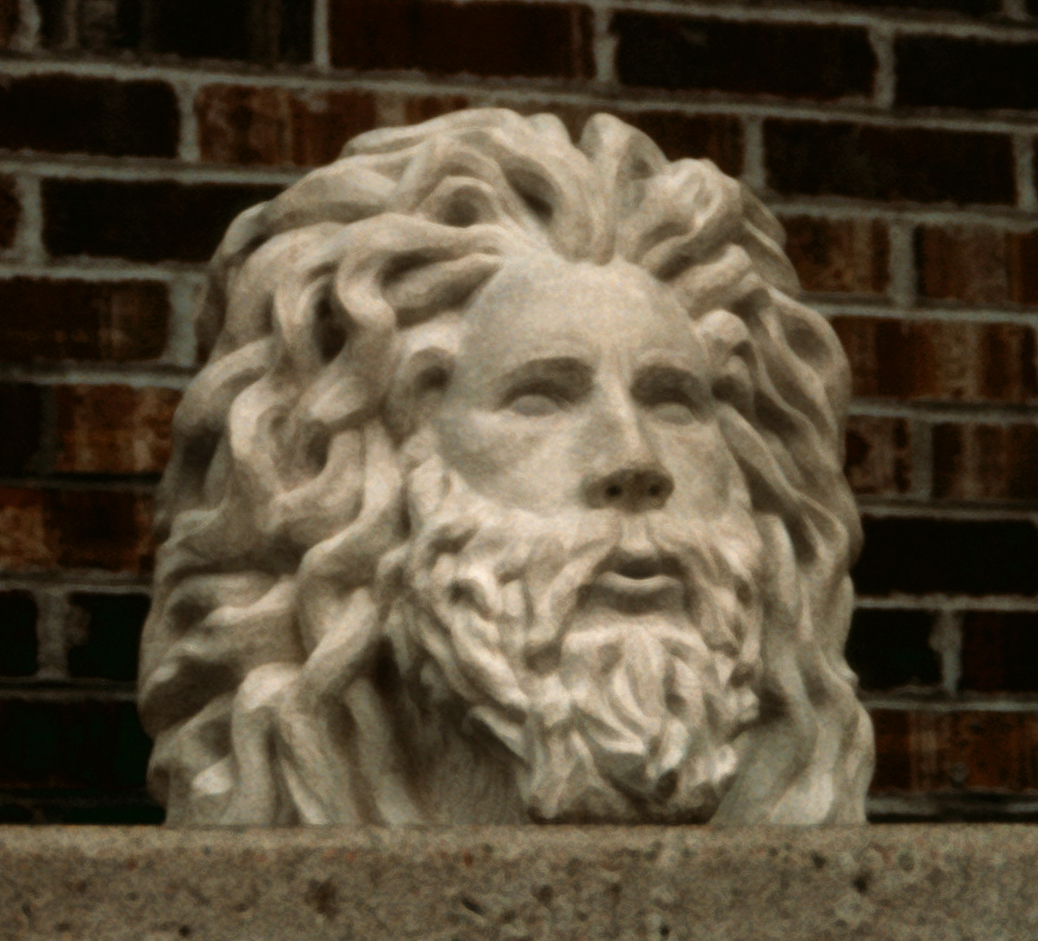
One of my first stone sculptures – "Zephyr" – God of the Wind.
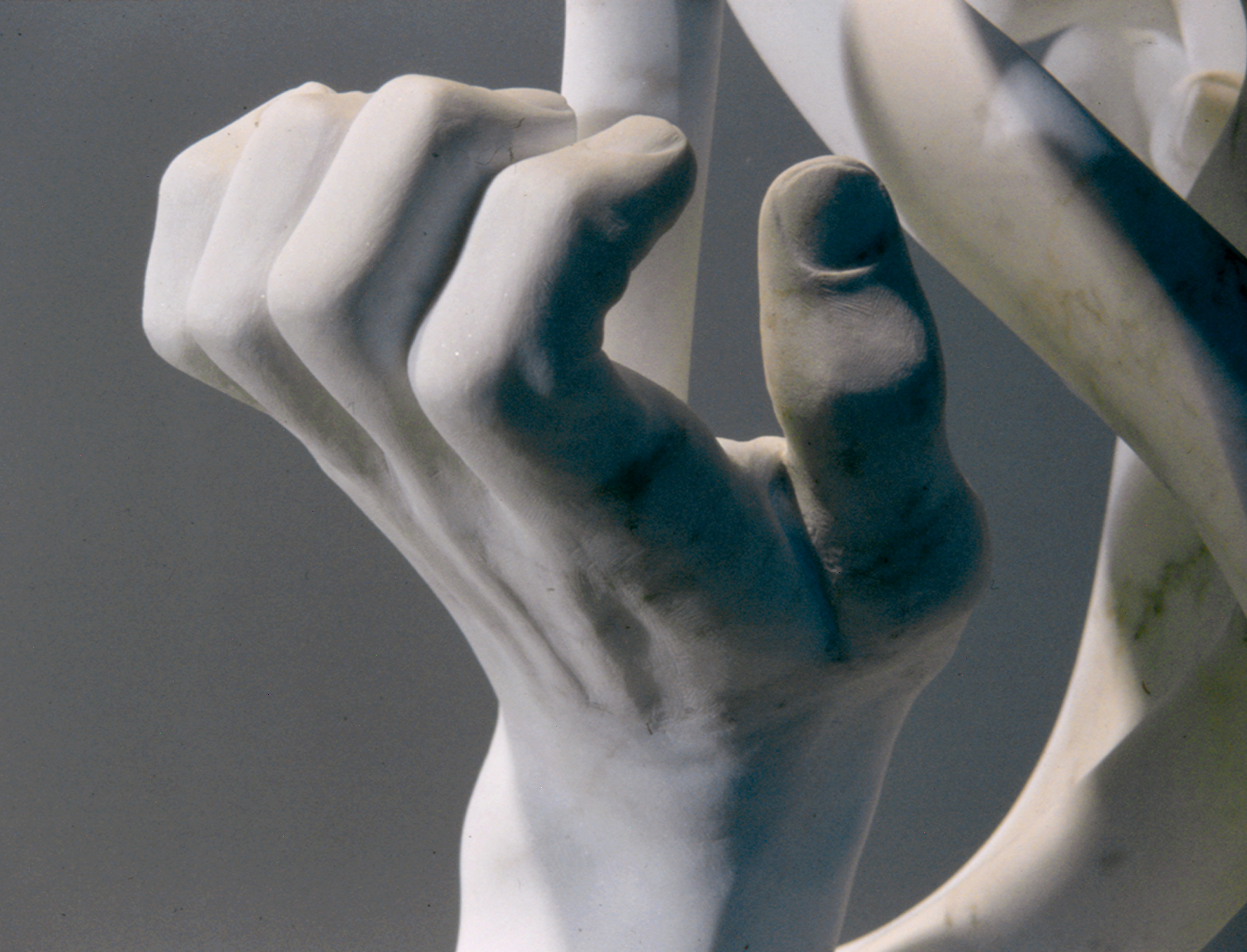
"Formation" Art college days, the dance between the material and the artist.
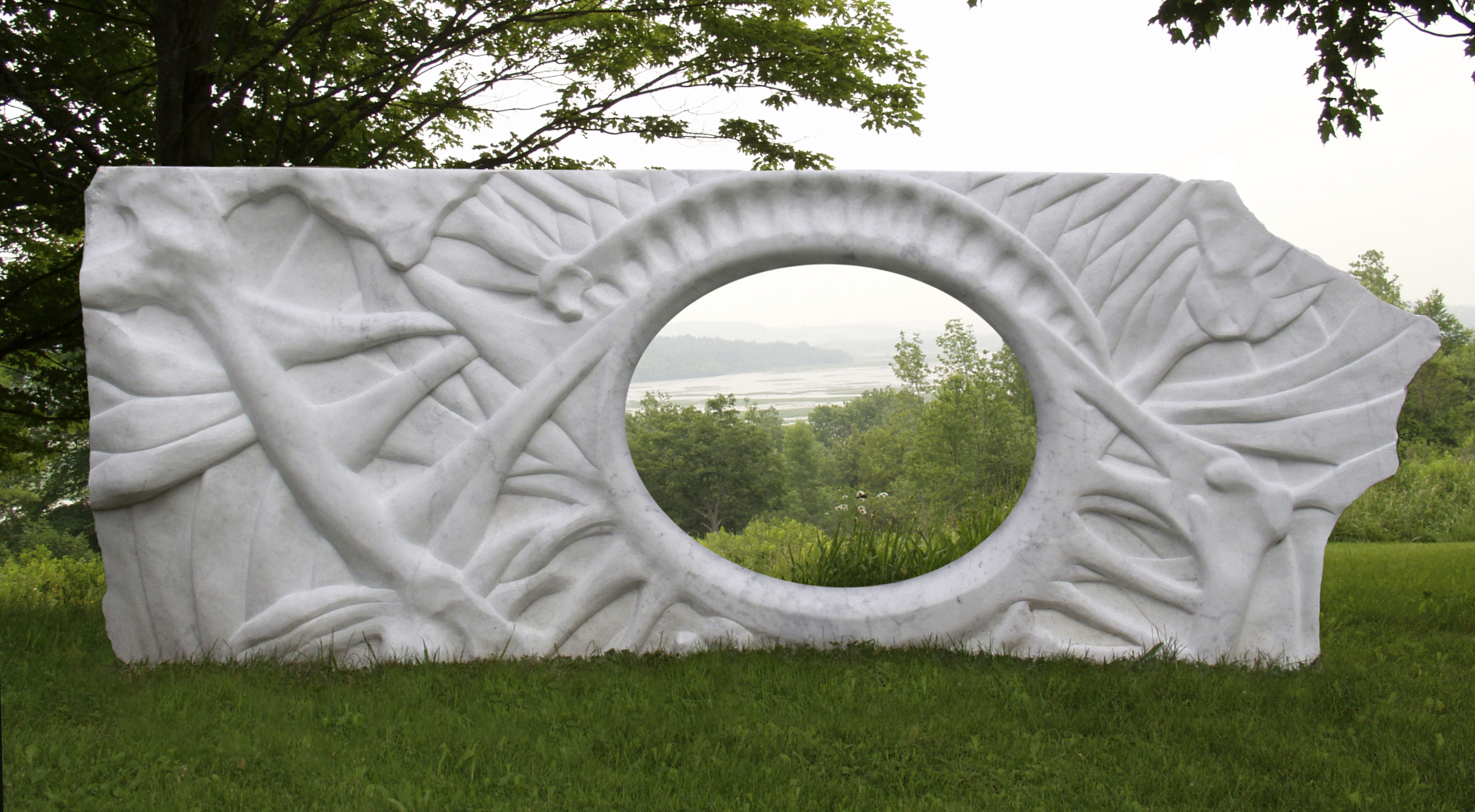 “Inner View” Marble. 2001 104”x42”x10’
“Inner View” Marble. 2001 104”x42”x10’I removed the surface and changed the structure of stone from crystal to muscle. This was part of a series that went on for a few years trying to get beneath the surface of things…
For me, what I call metaphorical art is sculpture that brings two or more unusual elements or representations together in a new way to suggest a meaning. For instance, the
“Shifting Culture” series combined the idea of ship hulls with iconic ancient civilization architecture. The ship hull is a fascinating manufactured object, made of a rib cage and skin, but instead of containing water, like us, it displaces it. A ship is in a precarious balance between weight and displacement, always trying to remain buoyant. My fascination with ancient cultures came from my first degree in history and anthropology. The “shifting culture” series developed from my concern over the loss of value placed on history. The great civilizations of the past have become commodities, bought and sold in markets around the world. I created a series of boat hulls transporting our displaced and commercialized history.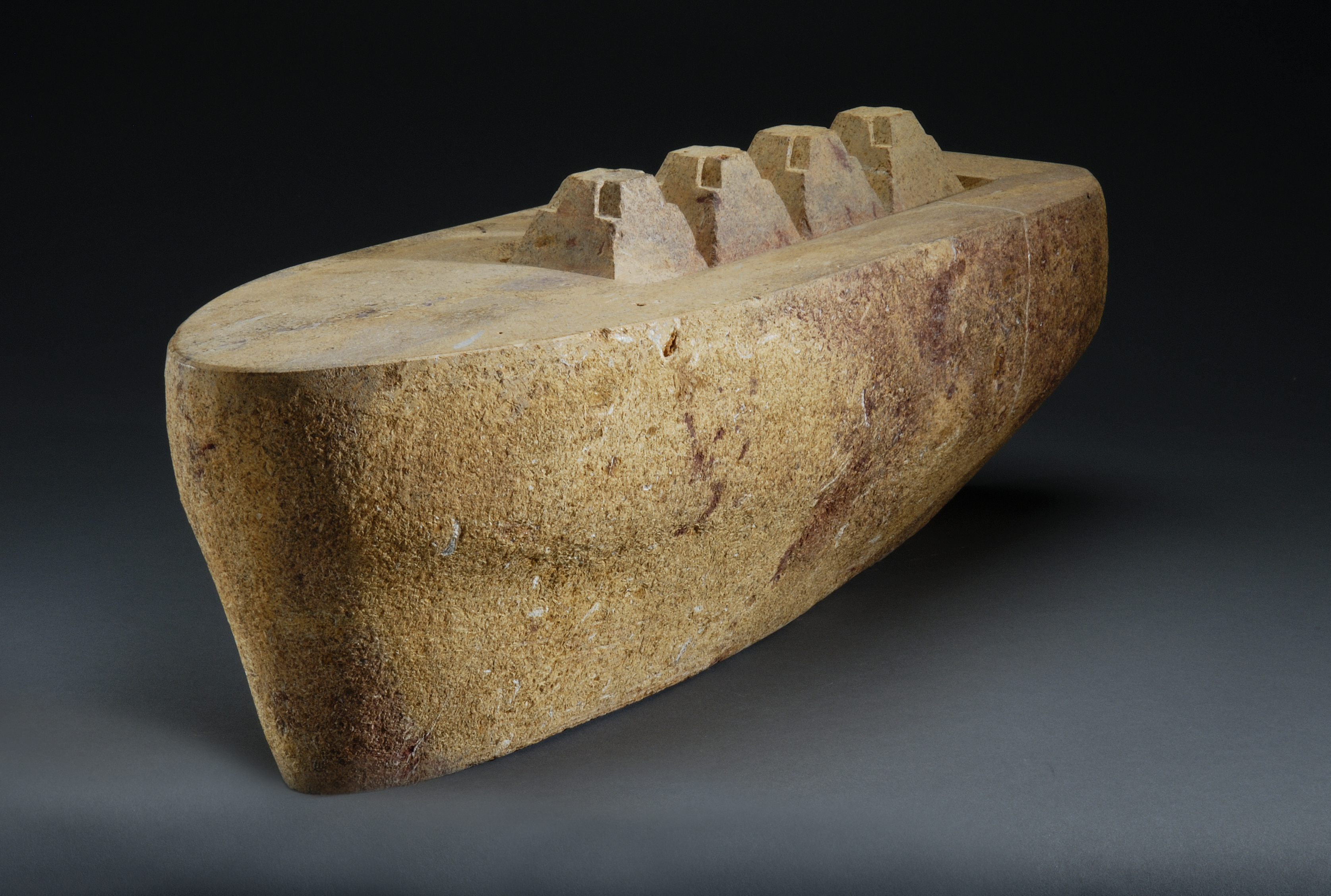
Staying with the boat hull, but moving away from archeology, my next series looked at the divergence between reason (the mind) and nature (the body). In “Symbiosis,” we are the rational “tokens” transported by the organic world almost against our will through the timescale of life. My question… What happens to an organism that chooses mind over body, that prefers an artificial constructed environment more than the biosphere that sustains it?
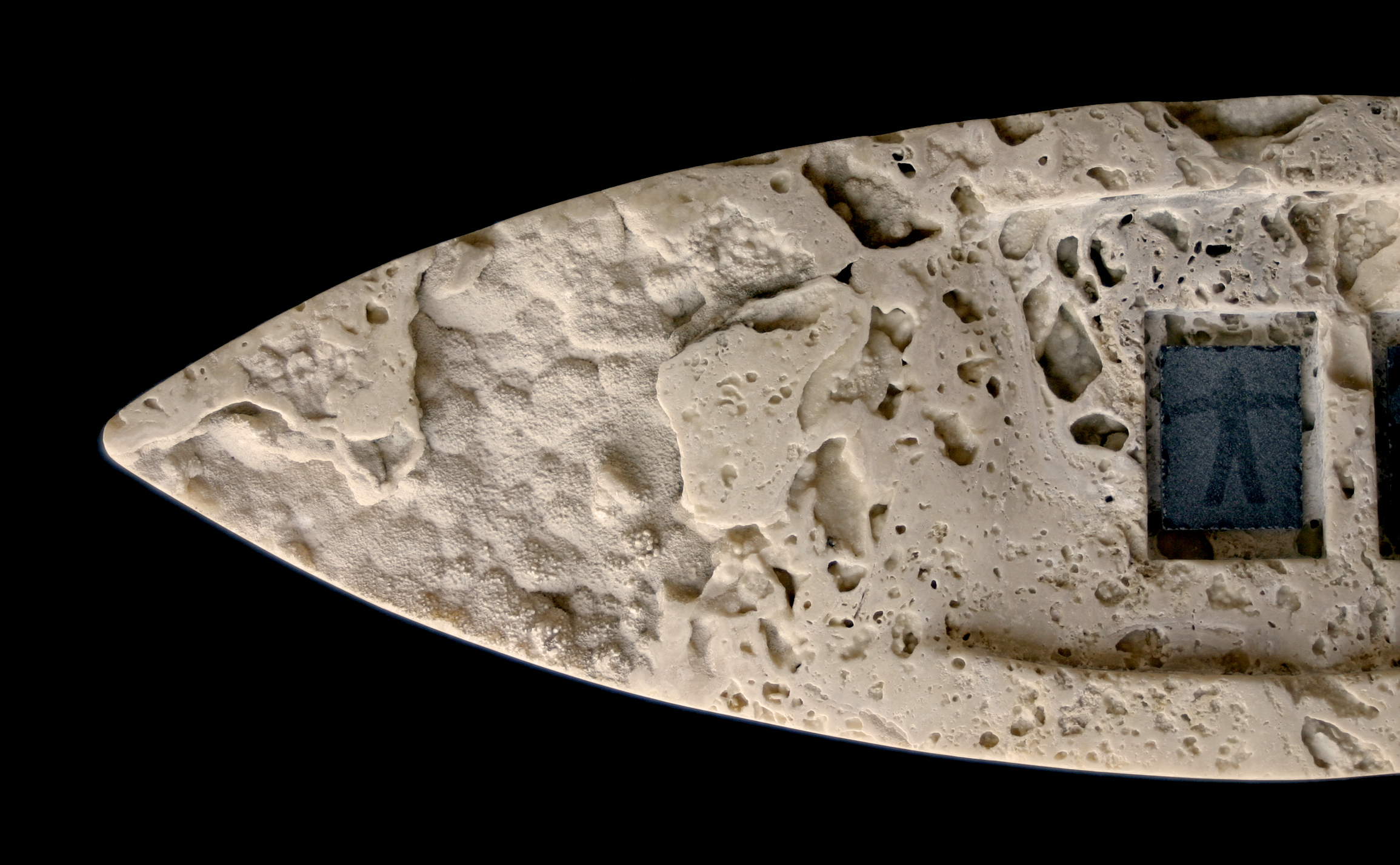
This series ended with the carving of a coelacanth (my interpretation) which is known as a living fossil. Definitely one of the strangest carvings I have ever done.
For these sculptures I found some wonderful boulders of tufa that were completely organic looking – filled with random holes, deposits and micro crystals.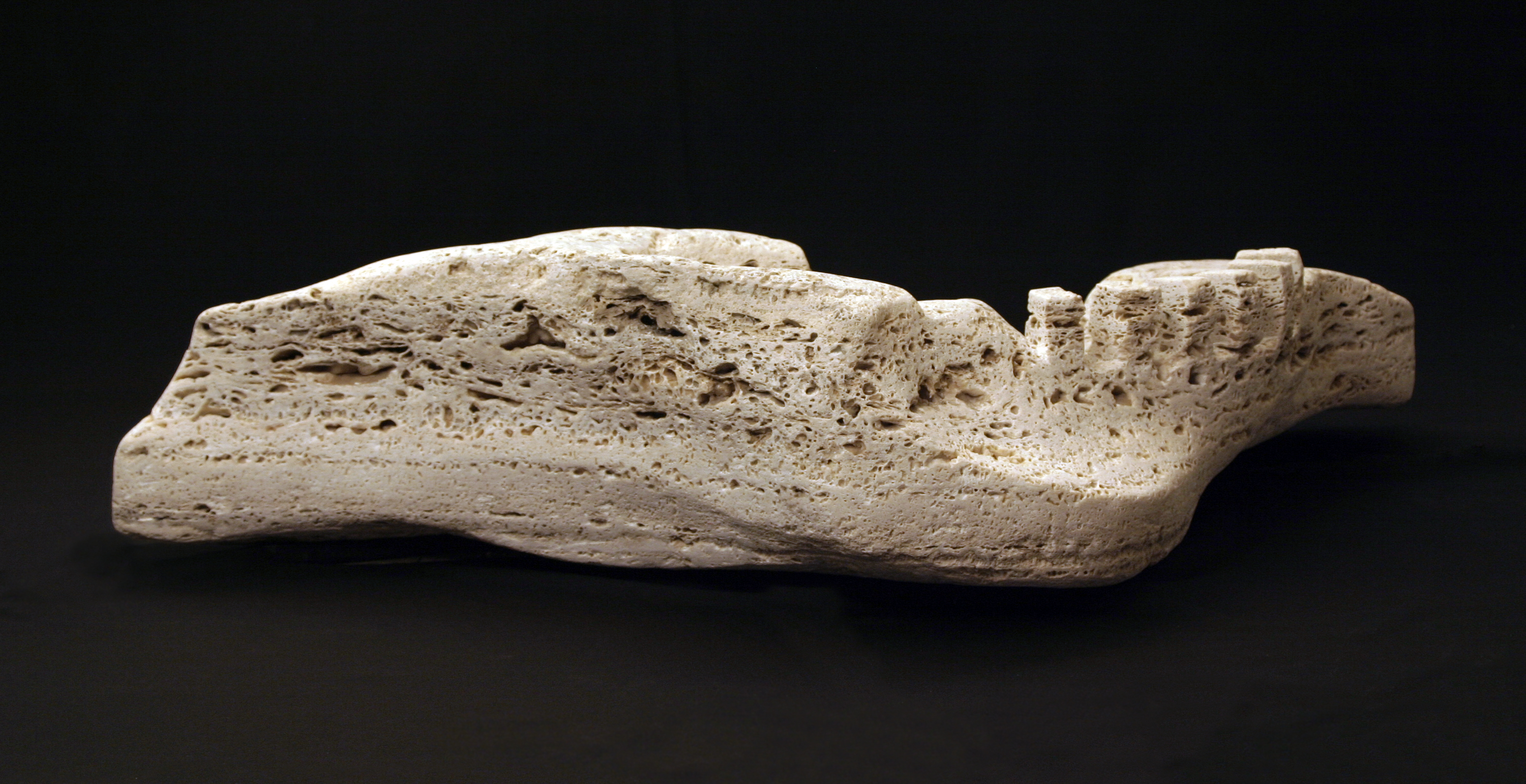
Tufa is formed when carbonate minerals precipitate out of a solution, like how stalactites form in a wet cave. The only difference with travertine is that travertine is precipitated from a hot (geothermal) solution usually making it a bit denser and harder.
I have carved stone for 20 years and seldom get tired of it. I have recently been exploring other materials either for large scale or to express things that can’t be captured in stone.
Some of my greatest memories came from the early years. I loved Art College, but there was a strong bias that “good art” was purely conceptual. I have often joked with my friends that it took years to recover as an artist from art school! For me, art in all its forms is expression; words are expression, movement is expression, even silence and stillness is expression! Everything has a context, every object is part of a space, every story echoes against a wall of history. As artists, I believe we are the interpreters, whether consciously or subconsciously, we fashion form, colour, texture, sounds, patterns, movement into new identities.
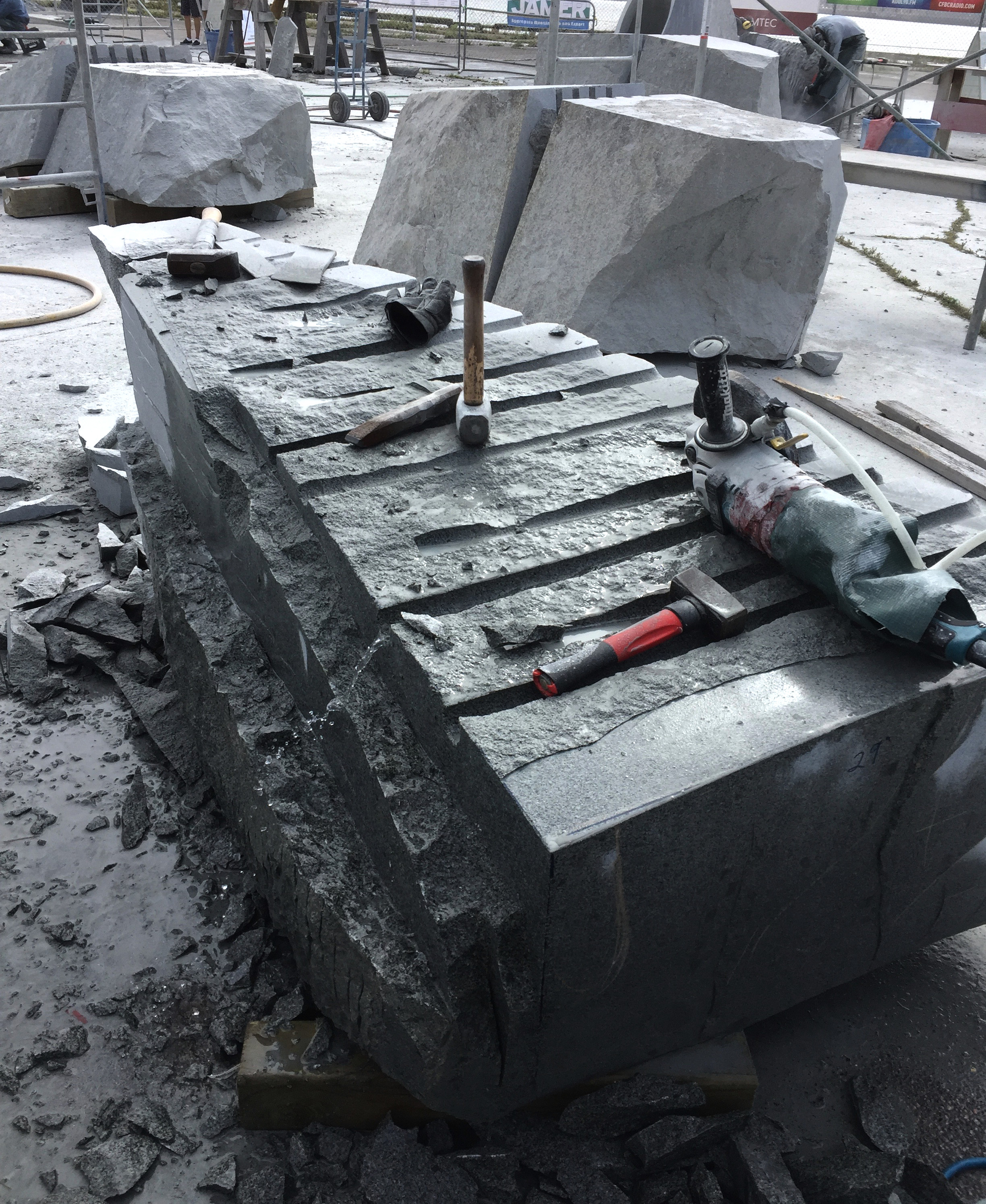 It was a great experience to attend the Saint John International Sculpture Symposium this past summer for six weeks. Working alongside seven other sculptors to cut through tons of granite, each creating our own vision for a public art piece.
It was a great experience to attend the Saint John International Sculpture Symposium this past summer for six weeks. Working alongside seven other sculptors to cut through tons of granite, each creating our own vision for a public art piece.
The sculpture I did is called “Song of the Deep” and it invites people to listen to the voices of nature in a new way and hear the life around us. It asks the viewer to consider the music of the ocean … a whole orchestra of sounds and songs we don’t hear. I created an audio graph of a particular Humpback whale song; the visual pattern of the resonance. The Humpback whale in particular is known to compose intricate and beautiful songs up to a half hour in length that transmit up to a mile through the ocean. The songs overlap in depth and volume beneath the waves.
I am intrigued by wave forms … not the ocean wave forms but sounds waves and patterns. They are beautiful and alive in their invisible world. Full of energy and direction until they dissipate into stillness.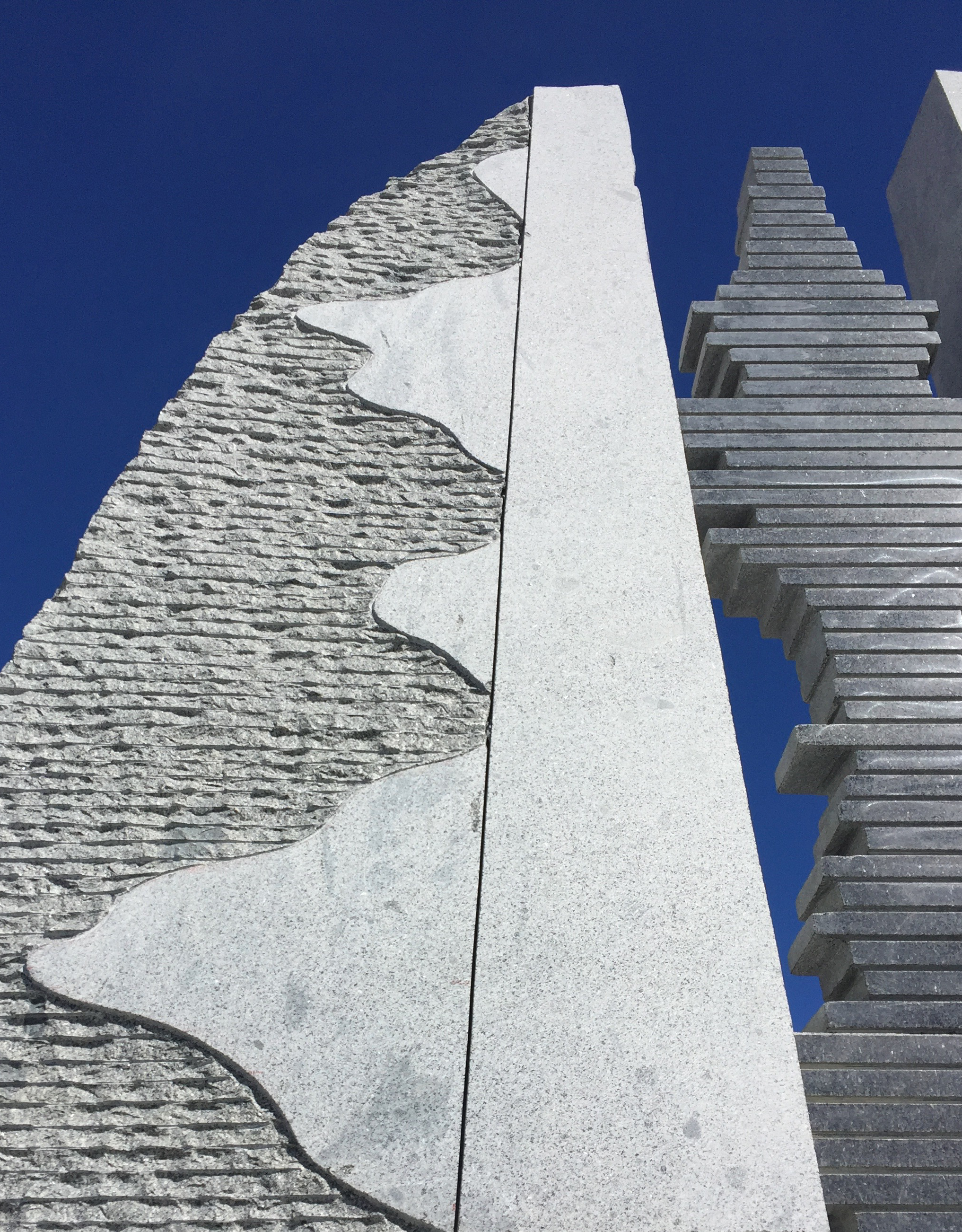
For this sculpture I was inspired by the Bay of Fundy with its massive tides that create their own resonance and rhythm, forming macro and micro ripples through the biosphere. These wave patterns merge with sound waves and songs to create intricate and complex overlapping harmonies. The whales are the largest voices in the natural ocean and come to the Bay of Fundy in the summer as their primary feeding ground. We had a wonderful trip to Saint Andrews one day to go out and see them in their habitat.
The sculpture I made has three main elements, the visualization of the whale song supported by granite blocks that have been split, like the song is splitting the earth and stone and reaching into the sky. The side stones form the outer shape, some say it appears as the jaw of a whale, and the resonance patterns extend into these stone, creating new sound patterns.
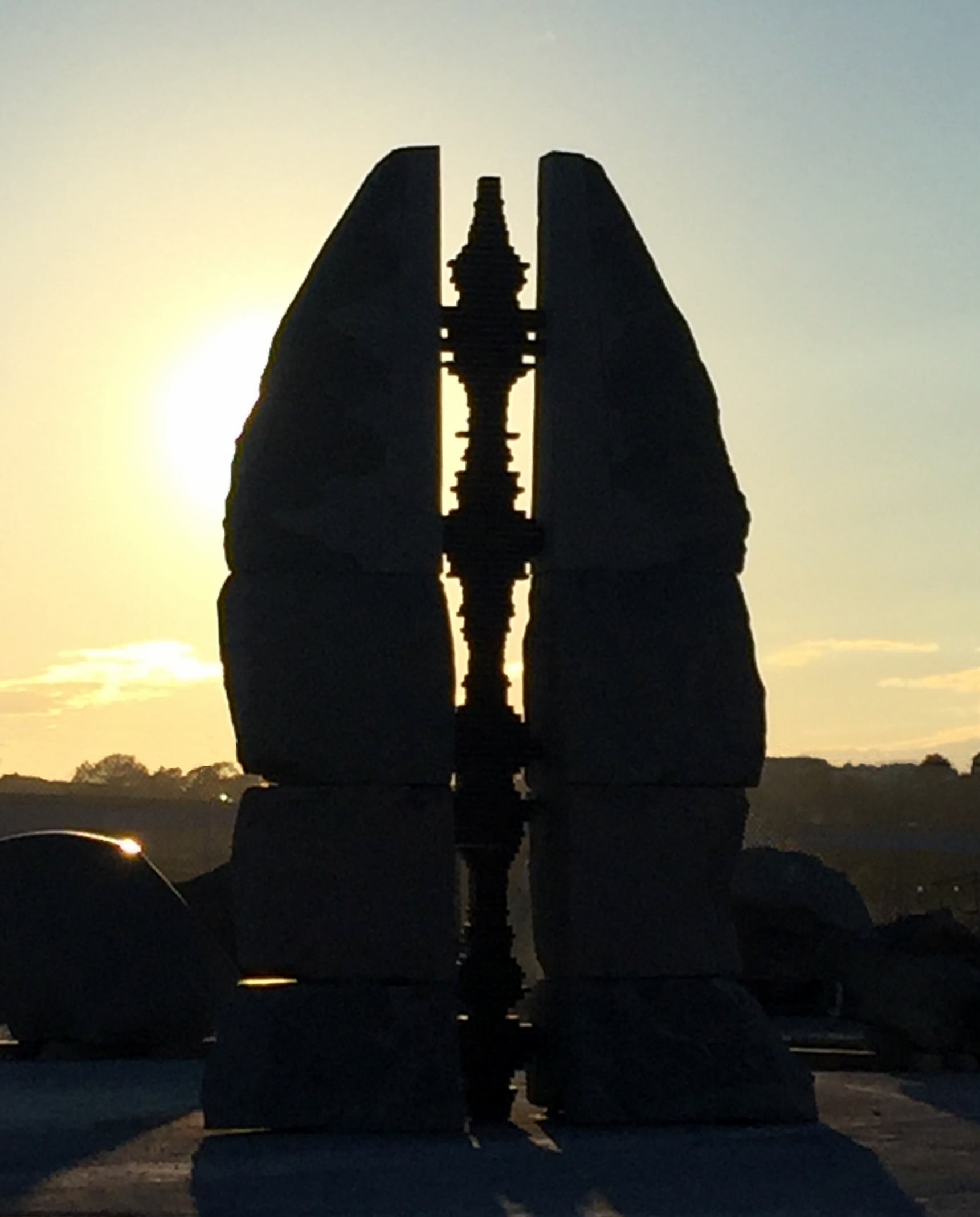 “Song of the Deep” 2018. 13’tall x 8.5’ x 4’
“Song of the Deep” 2018. 13’tall x 8.5’ x 4’
Part of this project is also interactive, viewers can listen to the whale song depicted in the sculpture on their own phone. The link is: https://ocr.org/sounds/humpback-whale/
It was a great opportunity to share knowledge with artists from Europe and Turkey. It seems a lot of the European artists use nine inch flush mounted blades on extra powerful grinders. I think grinders in Europe are rated differently than here as they get much higher wattage for the same size tool. We had 7” grinders with 7” flush blades. One of the biggest lessons in a symposium is not having the luxury of slowly working your stone down, one has to cut straight to your finish surface. You just take a deep breath and go for it! We would often burn through one 7” sintered diamond blade a day – and that was with water. The symposium was well organized and provided everything we needed to stay focused on our task. The evenings were full of laughter and stories and a few invented games that corresponded to the amount of alcohol consumed … but we all hit the pillow by 10pm exhausted from a heavy day’s work. We worked hard six days a week for six straight weeks, often the whole day with a gas powered saw.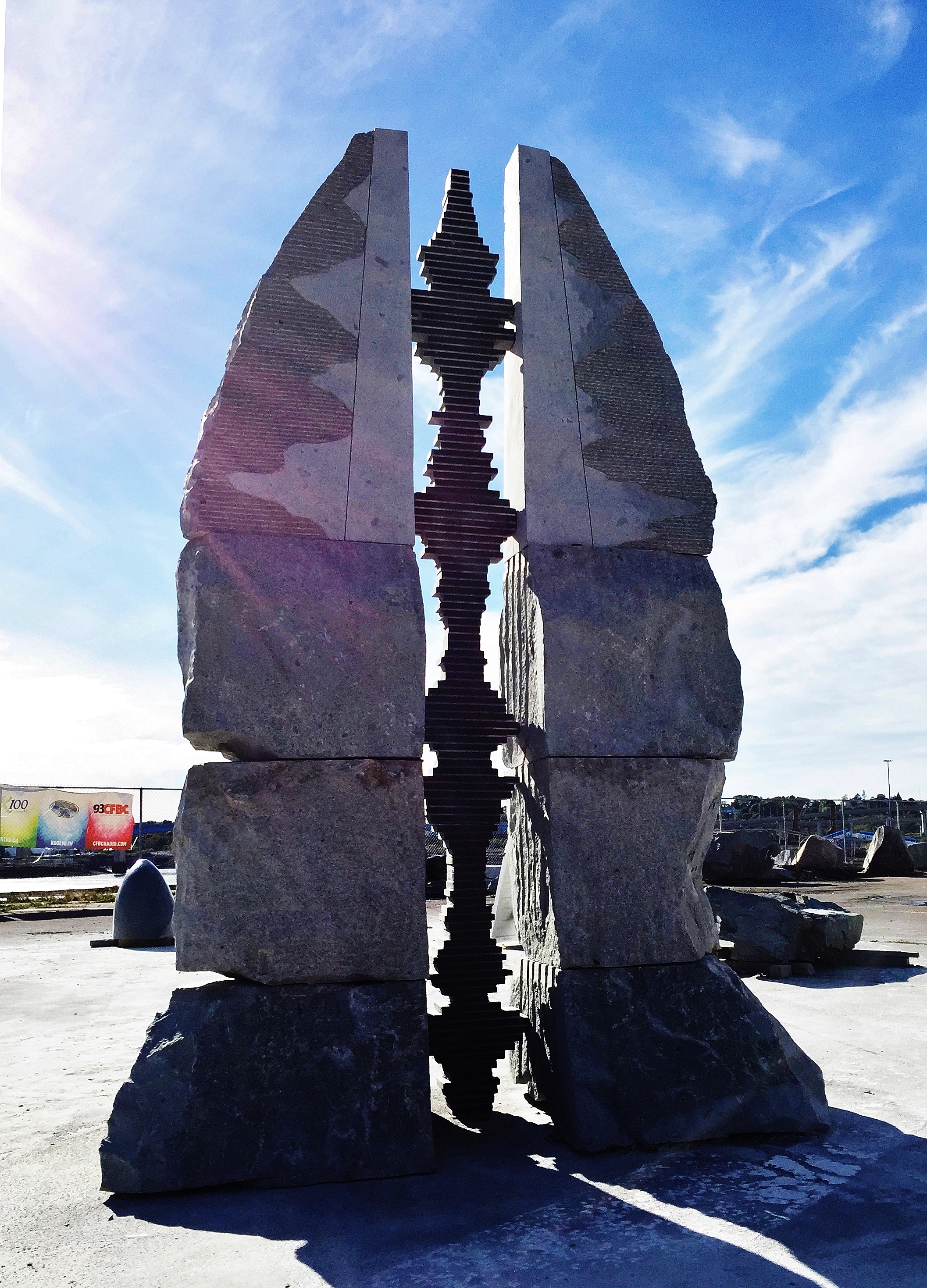
The stone we had, came from a quarry that used dynamite, so there were lots of fractures in it and it would not split in a straight line! This was one of the biggest challenges for me; I needed to split through several large boulders at exact right angles, so I ended up drilling all the way through, with holes 5” apart! It meant one full week of holding on for dear life to a big quarry rock drill that shakes you to the core. Fortunately, after being shaken silly, all the rocks split perfectly.
It was a great experience, setting out to do this sculpture, working through all kinds of hurdles and getting it all together on the 2nd to the last day! There were a few sleepless nights along the way but it all came together in the end. The best part of the symposium of course was the camaraderie with the other sculptors and interns and organizers, there was seldom a dull moment.
The last few years I have been consumed with an art related business so have had very little time for my own artwork. Spending six weeks carving granite really drove home the importance to create regularly … to focus on developing one’s voice and ideas at least some time every week. I have set a few new art goals and am looking forward to next year’s Pilgrim Firs already.
:) Oliver

Staying with the boat hull, but moving away from archeology, my next series looked at the divergence between reason (the mind) and nature (the body). In “Symbiosis,” we are the rational “tokens” transported by the organic world almost against our will through the timescale of life. My question… What happens to an organism that chooses mind over body, that prefers an artificial constructed environment more than the biosphere that sustains it?

This series ended with the carving of a coelacanth (my interpretation) which is known as a living fossil. Definitely one of the strangest carvings I have ever done.
For these sculptures I found some wonderful boulders of tufa that were completely organic looking – filled with random holes, deposits and micro crystals.

Tufa is formed when carbonate minerals precipitate out of a solution, like how stalactites form in a wet cave. The only difference with travertine is that travertine is precipitated from a hot (geothermal) solution usually making it a bit denser and harder.
I have carved stone for 20 years and seldom get tired of it. I have recently been exploring other materials either for large scale or to express things that can’t be captured in stone.
Some of my greatest memories came from the early years. I loved Art College, but there was a strong bias that “good art” was purely conceptual. I have often joked with my friends that it took years to recover as an artist from art school! For me, art in all its forms is expression; words are expression, movement is expression, even silence and stillness is expression! Everything has a context, every object is part of a space, every story echoes against a wall of history. As artists, I believe we are the interpreters, whether consciously or subconsciously, we fashion form, colour, texture, sounds, patterns, movement into new identities.
 It was a great experience to attend the Saint John International Sculpture Symposium this past summer for six weeks. Working alongside seven other sculptors to cut through tons of granite, each creating our own vision for a public art piece.
It was a great experience to attend the Saint John International Sculpture Symposium this past summer for six weeks. Working alongside seven other sculptors to cut through tons of granite, each creating our own vision for a public art piece.The sculpture I did is called “Song of the Deep” and it invites people to listen to the voices of nature in a new way and hear the life around us. It asks the viewer to consider the music of the ocean … a whole orchestra of sounds and songs we don’t hear. I created an audio graph of a particular Humpback whale song; the visual pattern of the resonance. The Humpback whale in particular is known to compose intricate and beautiful songs up to a half hour in length that transmit up to a mile through the ocean. The songs overlap in depth and volume beneath the waves.
I am intrigued by wave forms … not the ocean wave forms but sounds waves and patterns. They are beautiful and alive in their invisible world. Full of energy and direction until they dissipate into stillness.

For this sculpture I was inspired by the Bay of Fundy with its massive tides that create their own resonance and rhythm, forming macro and micro ripples through the biosphere. These wave patterns merge with sound waves and songs to create intricate and complex overlapping harmonies. The whales are the largest voices in the natural ocean and come to the Bay of Fundy in the summer as their primary feeding ground. We had a wonderful trip to Saint Andrews one day to go out and see them in their habitat.
The sculpture I made has three main elements, the visualization of the whale song supported by granite blocks that have been split, like the song is splitting the earth and stone and reaching into the sky. The side stones form the outer shape, some say it appears as the jaw of a whale, and the resonance patterns extend into these stone, creating new sound patterns.
 “Song of the Deep” 2018. 13’tall x 8.5’ x 4’
“Song of the Deep” 2018. 13’tall x 8.5’ x 4’Part of this project is also interactive, viewers can listen to the whale song depicted in the sculpture on their own phone. The link is: https://ocr.org/sounds/humpback-whale/
It was a great opportunity to share knowledge with artists from Europe and Turkey. It seems a lot of the European artists use nine inch flush mounted blades on extra powerful grinders. I think grinders in Europe are rated differently than here as they get much higher wattage for the same size tool. We had 7” grinders with 7” flush blades. One of the biggest lessons in a symposium is not having the luxury of slowly working your stone down, one has to cut straight to your finish surface. You just take a deep breath and go for it! We would often burn through one 7” sintered diamond blade a day – and that was with water. The symposium was well organized and provided everything we needed to stay focused on our task. The evenings were full of laughter and stories and a few invented games that corresponded to the amount of alcohol consumed … but we all hit the pillow by 10pm exhausted from a heavy day’s work. We worked hard six days a week for six straight weeks, often the whole day with a gas powered saw.

The stone we had, came from a quarry that used dynamite, so there were lots of fractures in it and it would not split in a straight line! This was one of the biggest challenges for me; I needed to split through several large boulders at exact right angles, so I ended up drilling all the way through, with holes 5” apart! It meant one full week of holding on for dear life to a big quarry rock drill that shakes you to the core. Fortunately, after being shaken silly, all the rocks split perfectly.
It was a great experience, setting out to do this sculpture, working through all kinds of hurdles and getting it all together on the 2nd to the last day! There were a few sleepless nights along the way but it all came together in the end. The best part of the symposium of course was the camaraderie with the other sculptors and interns and organizers, there was seldom a dull moment.
The last few years I have been consumed with an art related business so have had very little time for my own artwork. Spending six weeks carving granite really drove home the importance to create regularly … to focus on developing one’s voice and ideas at least some time every week. I have set a few new art goals and am looking forward to next year’s Pilgrim Firs already.
:) Oliver

